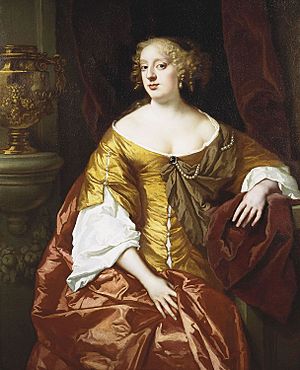Anne Spencer, Countess of Sunderland (died 1715) facts for kids

Anne Spencer, Countess of Sunderland (born Anne Digby; around 1646 – April 26, 1715) was an important lady in English society. She was the wife of Robert Spencer, 2nd Earl of Sunderland. Her parents were George Digby, 2nd Earl of Bristol and Lady Anne Russell.
Anne's Marriage and Family Life
Anne married Robert Spencer on June 10, 1665. Their engagement had been broken off before, but they soon got back together. Their mothers helped them reconcile, and they ended up having a very happy marriage.
Anne and Robert had at least five children who lived to be older:
- Lord Robert Spencer (1666–1688)
- Lady Anne Spencer (1667–1690), who married James Hamilton, 4th Duke of Hamilton
- Lady Isabella (1668–1684)
- Lady Elizabeth Spencer (1671–1704), who married Donough MacCarty, 4th Earl of Clancarty
- Charles Spencer, 3rd Earl of Sunderland (1674–1722). He married Arabella Cavendish, and later Anne Churchill. Anne Churchill was the daughter of John Churchill, 1st Duke of Marlborough and Sarah Churchill.
Anne also had two other children who sadly died when they were very young.
Life at Court and Friendships
Anne was a lady-in-waiting to Mary of Modena, who was the Queen during the reign of King James II. A lady-in-waiting is a female assistant to a queen or princess. Anne was even present when the Prince of Wales was born. She was the one who signaled to the King that his new child was a boy.
Anne became a very close friend of Sarah Churchill. Sarah later became the Duchess of Marlborough. However, Queen Anne did not like Anne Spencer. This was because Queen Anne was jealous of the strong friendship between Anne Spencer and Sarah Churchill.
People who knew Anne Spencer spoke well of her. She was known to be a woman of good character. She was also very devoted to her husband. Many believed that her happy marriage helped her husband through difficult times in his life.
Political Views
Like her husband, Lady Sunderland supported the Whig political group. The Whigs were one of the main political parties in England at the time.
In 1704, a new theatre was being built in London. It was called Sir John Vanbrugh's new theatre in Haymarket. The foundation stone of this theatre was dedicated to Anne. It called her "the little Whig," showing her strong support for the Whig party. This theatre is now known as Her Majesty's Theatre.

